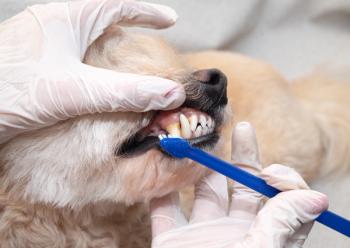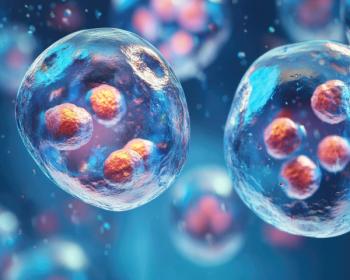
Managing dental emergencies (Proceedings)
Emergencies in veterinary dentistry are generally not life threatening. Unfortunately, trauma to the oral cavity and face can cause discomfort and pain with systemic complications if the patient is not able to eat.
Emergencies in veterinary dentistry are generally not life threatening. Unfortunately, trauma to the oral cavity and face can cause discomfort and pain with systemic complications if the patient is not able to eat.
Types of trauma
• Soft tissue trauma
• Tooth injuries
• Jaw fracture
Soft tissue trauma
Trauma to the soft tissue most often affects the lips and the hard palate. With soft tissue trauma there is an increased risk of hemorrhage. The goal of treatment is to control hemorrhage without compromising the blood supply. Contamination and particulate debris must be decreased. Debris can be cleared using gentle lavage. Contamination can be brought under control using a balanced electrolyte and antiseptic solution. Larger fragments and necrotic tissue can be removed manually while the wound is being cleaned. Surgical drains can be used in severely contaminated wounds.
Lip injuries
Degloving injury of the lower lip is a common occurrence in cats that have been hit by a car. Repair of this injury involves 2 options. If the degloved skin is still viable, it can be pulled back up and sutured around the canines and the interdental spaces of the mandibular incisors. If the skin is not viable, an advancement flap can be raised and anchored to the canines and incisors.
Nose injuries
Injuries involving the loss of part of the nose can be repaired using an advancement, rotation or transposition flap. It is important to ensure the patency of the nares and that the flaps are not sutured under tension.
Oronasal fistula (onf)
ONF refers to any communication between the oral cavity and the nasal cavity. ONF can occur by an acquired palatal defect where the trauma occurs from an outside source or it can be congenital. In either case, the defect or injury can be a source of infection and chronic irritation. Symptoms can include sneezing with a mucopurulent or bloody discharge due to the constant impaction of food, water and debris. Treatment of these wounds or defects requires flap surgery, rigorous home care, and diligent follow-up with sedation and probing for possible dehiscence. Soft food must be fed during the entire healing phase. No chew toys or treats are allowed. Cleft palate repair does require the placement of an esophagostomy feeding tube to allow the patient to get nutrition and medication pre and post-operatively. Referral to a dentistry or surgical specialist is not uncommon.
Repair of hard palate defects
There are four commonly used flap techniques.
1. Langenbeck Technique
2. Overlapping Double Flap
3. Split Palatal U-Flap
4. Silicone or Acrylic Prosthesis
Langenbeck Technique
This is the most familiar technique in the general practice. The margins of the defect are debrided. An incision is made along the dental margin on either side. It is important to remain clear of the palatine artery. The flap is lifted along the dental margin and along the edge of the defect to allow movement of the tissue. The edges along the defect are brought together and sutured leaving the exposed bone to granulate. There can be a breakdown of the repair at the rostral end.
Double Overlapping Flap
This technique brings a decreased risk of rostral breakdown. The epithelial margins of the defect are debrided. Two incisions are made – along the dental margin encompassing the width of the defect and a flap is made and secondly along the far edge of the defect on the opposite side. The large flap is flipped over on itself, covering the defect and tucked under the small raised flap along the edge of the defect. The edges are sutured. The exposed palatine bone is left to granulate in.
Split Palatal U-Flap
This technique is used for large caudal defects of the palate. The margins of the defect are debrided. An upside-down U incision is made rostral to the defect and incised along the midline of the flap. Both flaps are raised off the bone being careful not to transect the palatine artery. Each of the two flaps is rotated 90 degrees to cover the defect and sutured to each other. The exposed bone is left to granulate in.
Defects of the soft palate
Clefts of the soft palate are usually congenital. These can be very large defects and time consuming to repair. It is imperative to have good visualization and easy access to the whole length of the defect. A double layer closure is required for success.
Defects of the maxillary alveolus
This defect is most familiar to the general practitioner. They can occur as a result of advanced periodontal disease causing destruction to the bony wall of the alveolus between the oral and nasal cavity. These defects are usually found along the palatal side of the maxillary canines using a periodontal probe. A small amount of water can be lavaged up into the defect and will come out through the nose. This condition can also occur if there is a periapical lesion caused by endodontic trauma or periodontal disease. Lastly, the defect can occur by an iatrogenic cause when extraction causes afracture of the bony wall.
There are two repair techniques.
1. Single Layer Closure
2. Double Layer Closure
Single Layer Closure
This is the most commonly done repair. The canine tooth is extracted and the extraction site is flushed and debrided. The edges of the alveolus are smoothed and a small area of palatal mucosa is raised and the edges scarified. Wide releasing incisions are made from the mesial aspect of the third incisor to the distal aspect of the first premolar. A mucoperiosteal flap is raised extending into the alveolar mucosa to assure enough tissue for a tension free closure. The flap is pulled over the defect and the sutured closed.
Double Layer Closure
This repair is done if the defect is very large or previous repairs have failed. The same steps are taken for a single flap closure with the addition of a palatal flap. A palatal flap which is the width of the defect is raised that extends from the palatal margin of the defect to the palatal midline. The mucoperiosteal flap is raised. The palatal flap is flipped over on itself and sutured down and the mucoperiosteal is rotated and placed over the palatal flap and sutured down.
Traumatic tooth injuries
Traumatic tooth injuries can involve tooth fracture and /or damage to the periodontium. The causes can be hit by car, blunt force trauma or chewing on hard objects.
Damage to the periodontium
Subluxation
With this condition, the periodontium has been loosened due to trauma to a point that the tooth is mobile. The tooth has increased horizontal movement but no vertical displacement. No procedures need to be done, but soft food and no chew toys are recommended during the healing. If the pulp of the tooth become necrotic, a vital pulpotomy procedure may be necessary.
Luxation
With this condition, the tooth has been displaced in a vertical direction. The tooth has mobility upward (extrusion), downward (intrusion) or laterally.
Extrusion
These teeth have mobility both horizontally and vertically. The tooth can appear taller than the contra lateral tooth. On radiographs the periodontal ligament space is increased.
Intrusion
These teeth have been pushed apically and are firmly entrenched in the alveolus. The tooth can appear shorter than the contra lateral tooth. On radiographs the periodontal ligament space appears narrower.
Lateral Tooth Luxation
With this condition, trauma has pushed this tooth in either a buccal, labial, lingual or palatal direction. Oftentimes, the alveolus is also fractured. The luxated tooth can be repositioned in the alveolus and stabilized using an acrylic splint.
Avulsion
With this condition, the tooth has been completely extruded from the alveolus. The tooth should be placed in saline or milk and should be replanted within 30 minutes of trauma. Contraindications for this procedure are primary teeth, teeth with periodontitis and teeth with carious lesions and tooth resorption.
Jaw fracture
The most common cause of the jaw fracture is being hit by a car. It also can be caused due to advanced periodontitis which can lead to spontaneous jaw fracture, usually in the mandibular premolar region. Lastly, jaw fracture can be caused due to excessive force during an extraction in an already weakened jaw. This can be avoided by taking radiographs before starting the extraction.
The most common sites for jaw fracture are the mandibular symphysis, mandibular body, mandibular ramus and the maxilla. In the maxilla the bones most prone to fracture are the zygomatic, palatine, frontal, nasal and maxillary bone. Dental radiographs are critical to diagnosis and treatment planning.
Maxillary fractures
Fractures of the maxilla can occur from trauma or pre-existing conditions. Those fractures where this a minimum of displacement can be stabilized using a tape muzzle.
With more severe fractures, stability can be provided using any maxillary non-mobile teeth as anchors for interdental wiring with dental acrylic laid on top to make a splint. The splint should be kept in place for 6-8 weeks.
Palatal fractures
Palatal fractures are usually presented as midline clefts at the interincisive suture. It usually occurs with young patients. Narrow defects will heal without the need for surgery. Larger defects can be repaired by debriding the cleft and then suturing the palatal soft tissues. With very large defects, a interproximal wire can be placed between the maxillary third incisors with the knot placed at the dorsobuccal aspect to avoid contact with the mandibular canine. Healing takes 3-4 weeks.
Mandibular fractures
Rostralventral fractures of the mandible are repaired either by tightly suturing the soft tissue back in place possibly anchoring an acrylic splint to the teeth caudal to the fracture. In some cases, if the fragment has lost its blood supply, the fragment can be removed and a advancement flap is raised to suture the soft tissue closed.
Caudoventral fractures of the mandible are usually unstable and usually require the use of interdental or intraosseous wiring and an acrylic splint to provide stabilization.
Fractures of the mandibular ramus and condyloid process are uncommon. If the area is unstable, and grossly displaced, the ramus can be wired.
Symphyseal separation is a separation of the two sides of the mandible where they meet at the mandibular symphysis. This condition is commonly seen in cats. The two sides of the mandible can be brought back to the correct position. A circumferential wire is placed around the rostral portion of the mandible and twisted at the bottom of the jaw. A figure-of-eight wire is placed between the mandibular canines and held in place with dental acrylic.
Bibliography
Bellows J. Oral surgical equipment, materials and techniques. In: Small Animal Dental Equipment, Materials and Techniques: A Primer. Ames, Blackwell, 2004, 297-361.
Gorrel C. Emergencies. In: Veterinary Dentistry for the General Practitioner. Saunders, Edinburgh, 2004, 131-155.
Taney KG, Smith MM. Problems with muscles, bones and joints. In: Niemic BA. Small Animal Dental, Oral and Maxillofacial Disease. Manson, London, 2010, 199-224.
Verstraete FJM. Maxillofacial fractures. In: Holmstrom SE, Frost Fitch P, Eisner ER. Veterinary Dental Techniques for the Small Animal Practitioner, 3rd ed. Saunders, Philadelphia, 2004, 559-600.
Newsletter
From exam room tips to practice management insights, get trusted veterinary news delivered straight to your inbox—subscribe to dvm360.






